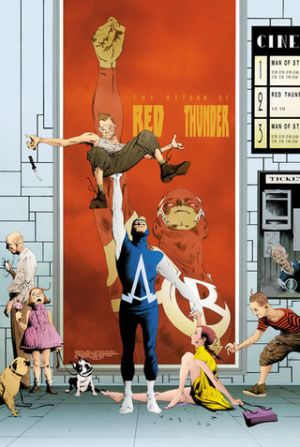Comics /
Comic Reviews /
DC Comics
Animal Man #20 Review
By Zak Edwards
May 2, 2013 - 12:34
Much of the reason that I love Jeff Lemire is his approach to his audience. For me, pretension is when an artist simply doesn’t trust his audience to make the connections they want, so things are spelt out repeatedly, as if begging the audience to recognize the artist is a genius and should be grateful for a guiding hand. It’s the reason I hate the movie Drive, with its Sophia Coppola-style detached dialogue and constant hammering of themes, broad and easy as they are. Lemire, by contrast, welcomes his audiences into his world, letting them explore what he’s made. Not to say he hides his authorial voice all the time, the ending of Sweet Tooth lacks that type of disguise to usher in a heartfelt goodbye, but he certainly has enough faith in his audiences to ‘have what it takes’ to draw meaning from his work. Warning: spoilers ahead.
 |
| As a side note, I'm pretty sure Buddy is going to accidentally kill a small child or old man in this cover. Watch that knife! |
After an alienating and overblown crossover, Animal Man settled back into a new status quo last month, only to remove itself entirely from its protagonist, albeit in the form of a crappy film. In this issue, Lemire is getting dangerously close to pretentious with “Tights,” a film starring Buddy about Red Thunder, a divorced man with kids whose superhero career is exploited and monetized by the Hollywood machine. The issue, and film, follows the character through his meanderings of the stereotypically lowest places of Hollywood: talent shows, reality TV, late night shows, endorsements, and gossip columns. His whole existence is fake, designed to cash in on a viral video of Red Thunder getting the crap beat out of him, and does little more than moan about the state of the entertainment industry. The commentary culminates in two moments: one where Chaz’s stopping of a rape leads to his downfall (with people spouting tired, old lines like “You’re dead in this town!”) because the would-be rapist is a high-powered executive, and when he no longer owns the Red Thunder trademark because of his ‘infraction’ (which leads to tired, old lines like “Use that costume again and I’ll destroy you!”). The story reads like the ones we all hear everyday, the quick cashing in on fame, from Snooki’s novel to guest judging on America’s got talent for forgotten celebrities, but it feels, well, old.
And the worst part is the excuse for this tired writing: it’s a heavy-handed metaphor for Buddy Baker’s current existence. Since Buddy’s family has left him in the wake of his son’s death, the final pages of him sitting in a crappy apartment, watching his own crappy movie, make everything crystal clear, as if audiences wouldn’t instantly recognize Buddy’s predicament in his former character. And now, spoiler alert, as Buddy is drawn back into the world of celebrity through his Oscar nomination, I suspect this series will take audiences through similarly tired models of the entertainment industry to watch Buddy be sucked in for various reasons. Perhaps the entire comic is a commentary on the terrible films made for the Oscars, like terrible race politics of “The Help” or spectacle-fueled self-congratulatory politics of “Zero-Dark Thirty,” but I suspect this series has simply lost its momentum. I will be back next month, which isn’t a very good practice for encouraging good comics, but I hope Lemire’s story finds some rejuvenation now that the “Rotworld” debacle has left its mark in the form of Max’s death and little else.
Guest Artist John Paul Leon’s heavily shaded art is reminiscent of the Sean Phillips/Michael Lark school of noir-esque sensibilities and, as a choice of ‘cinematography’ for this fake film, it works well. His lighting choices between the plasticized in front of cameras spectacle against the darker ‘reality’ is a careful and strong juxtaposition, but only reinforces the simple binary of fake Hollywood and real life. His more rigid paneling reflects its filmic quality, varying only slightly on an eight-panel grid that uses a double-wide panel or two every page. The artwork is an excellent choice and serves Lemire’s script well.
Grade: 5/10 This book is tired and needs a jolt of some sort.
Last Updated: January 17, 2025 - 08:20
